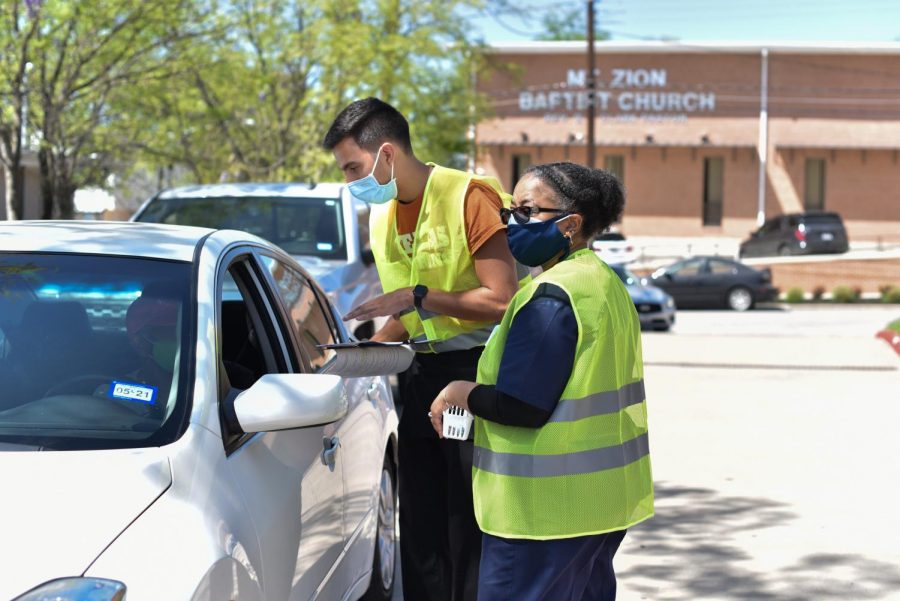“‘Vaccine curiosity’ is kind of meant to be an antidote for fear. We are hoping to provoke people’s own innate curiosity to learn more.”

Photo credit: The Daily Texan
The term “vaccine hesitancy” is all the rage—but does it adequately explain what is going on in the minds of those who are hesitant to get the COVID-19 vaccine? By focusing on the hesitancy of individuals, do we risk losing sight of fundamental problems of access, equity, and trust? This episode features two interviews with experts whose work straddles the lines between medicine, community outreach, and health communications. First, we talk with Dr. Shalonda Horton, Clinical Assistant Professor at the University of Texas at Austin School of Nursing, who is working on the frontlines at mobile vaccine clinics in Austin that partner with local community organizations to educate and support people about the vaccine. Then, we check in with Chelsea Brass, a communication studies doctoral student and former doctoral fellow for the Center for Health Communication in the Moody College of Communication and Melanie Connolly, a medical illustrator, 3-D animator and marketing director for the Austin Healthcare Council, about their new Vaccine Curiosity Tool, designed to help resolve uncertainty about the COVID-19 vaccine.
Mobile Vaccine Operations
Dr. Horton and the UT School of Nursing began partnering with local community organizations as part of a new initiative to deliver COVID-19 vaccines to Austin-area residents who have limited access to large vaccine hub sites. The effort resulted in two vaccine delivery programs: VAMOS (which stands for “Vaccine Administration Mobile Operations”), a mobile clinic set up at local churches and other community sites) and VaxNow (which stands for “Vaccinate, No Waste”), a program that delivers extra vaccines that are set to expire to individuals who are homebound or have difficulty accessing vaccine appointments). The idea for the initiative took shape when faculty at the UT School of Nursing started noticing the barriers patients were facing when trying to access vaccine hub sites. While some patients told stories about lack of transportation and limited access to online appointment scheduling, others were dealing with trust issues—specifically, lack of trust in public health institutions. “We knew we needed to get creative,” says Dr. Horton.
Relationship, Trust, and Accountability
When choosing community organizations to partner with, Dr. Horton says her team chose two African American churches with whom they already had established relationships. “Those relationships over years and time helped us get in the doors and say, ‘Hey, can we partner with you to vaccinate your congregation?’” Dr. Horton explains. “Relationship is huge to establishing trust.” Other factors that are vital to addressing issues of “hesitancy” in individuals and communities are reliability and accountability. “It’s about follow-through,” says Dr. Horton. “Not just showing up when I need something, but showing up when my community partner wants me to participate in community outreach. It continues to let them know that the entire nursing community is committed and invested.”
For many groups and communities that have been historically underserved, mistreated, or even abused by the public health and medical care systems, the term “hesitancy” fails to capture the issue. This is one reason why the Hogg Foundation has started using the term “vaccine equity” to talk about this phenomenon. “I really do think it is an equity issue,” agrees Dr. Horton. “We need to start framing it from that lens.”
Common Curiosities
In many cases, the questions that medical professionals like Dr. Horton are encountering from the not-yet-vaccinated include common ones about the nature of vaccines in general (“Is the virus inside the vaccine?” Answer: No.), or the speed of vaccine development (“Didn’t they rush this?” Answer: Also no.). Rather than framing these information exchanges as “myth-busting” or “fact vs. fiction,” health communicator Chelsea Brass and medical illustrator Melanie Connolly opted for more positive messaging when designing their Vaccine Curiosity Tool, which uses animations and voice-overs to explain the function of the COVID-19 vaccine in a digestible format. Brass and Connolly agree that the concerns voiced by the curious and hesitant are completely valid—and not something for which to shame people. “People are coming to these concerns through forethought. They’re not just blatantly making sudden generalizations,” says Connolly. “They’re looking at the researcher and looking at the information that they’re getting, but they may not come to the same conclusions as everybody else or as everybody who is working on the vaccines or as everybody who does have a level of trust.”
“‘Vaccine curiosity’ is kind of meant to be an antidote for fear,” Brass explains. “We are hoping to provoke people’s own innate curiosity to learn more.”
Related Content
